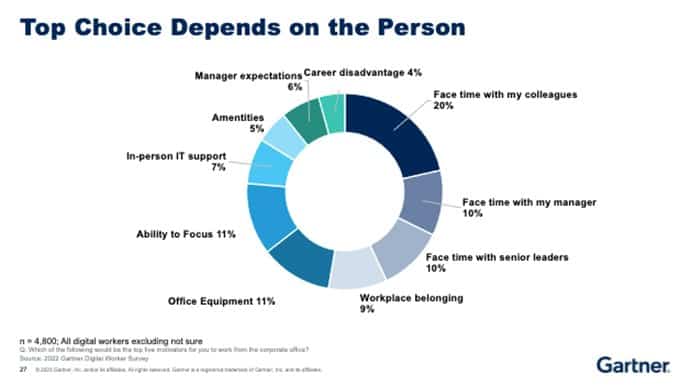A recent Gartner survey found that 77% of digital workers want to participate in creating their hybrid work model, while 14% prefer to have their hybrid work environment mandated.

“One of the biggest challenges to hybrid work is the lack of alignment between the variability between what workers want and the predictability organisations, managers and workers need to be effective,” said Caitlin Duffy, director in the Gartner HR practice.
She added that as employee wants and needs have shifted, organisations must respond thoughtfully to maintain productivity and avoid attrition.
Hybrid meetings are both unproductive and unpopular
Nearly half of digital workers surveyed by Gartner (47%) shared that they preferred to spend the highest percentage of time in virtual meetings, with audio and/or video, and the lowest percentage of time in hybrid meetings where some attendees participate in an in-person group setting and others join via webcam or phone.
Respondents ranked hybrid meetings as second-least productive (17%), with audio-only meetings least, and in-person meetings as the most productive (46%).
Digital workplace leaders can facilitate productivity, and improve user experience, during hybrid meetings by ensuring all participants can see and hear everyone clearly; interact with in-meeting content sharing and conversation; join the meeting with only one button or link; and seamlessly move across operating systems and devices.
“In addition to improving hybrid meetings, leaders and managers should assess the meeting culture in their organisation and ensure an intentional mix of asynchronous and synchronous work,” said Duffy.
Monitoring needs to come with benefits for employees
Many organisations have implemented employee productivity monitoring as a means to understand what workers are doing in a less visible hybrid work environment. When utilised due to mistrust, employee monitoring systems seek to determine if employees are active on devices and in applications, or whether employees are attending the office as mandated.
At the highest level of trust, employee monitoring efforts help managers see which employees are most productive and why, or whether business outcomes are being met. In this scenario, 96% of employees are more willing to accept monitoring if it leads to assistance that benefits them:
One-third of digital workers would accept monitoring in exchange for:
- Support in finding information or data to do their job (one-third)
- Proactive outreach from support (30%)
- Streamlining information and notifications as well as getting advice on performance improvement (28%)

“Progressive organisations are pursuing radical transparency around when data is being collected, what data is collected, how long it’s kept, who has access to it, and for what purpose it is being collected,” said Tori Paulman, senior director analyst at Gartner. “This includes giving employees an opportunity to opt-in to information and data gathering.”
Return to office motivators
The survey revealed a diverse set of motivators for digital workers to return to the office (see Figure 1), namely:
- “Facetime” — 40% of workers listed meeting in person
- Workplace amenities — 45% of workers want access to office equipment (ergonomic desks, monitors, printers, and Wi-Fi), the ability to focus, workplace belonging, in-person IT support, and office amenities like parking, fitness centres, daycare, and lunch.
- Consequences — Only 10% of workers shared those consequences, such as expectations from their manager or concern they would be at a career disadvantage.
Figure 1: Top choice depends on the person

Duffy believes that as the workplace continues to evolve so does the employee experience. “Increasingly, HR will need to partner with digital workplace leaders to ensure they are crafting the desired digital employee experience,” he concluded.





